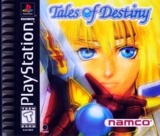A few steps forward, a few back. A good game missing a few key features in its day and age.
Gameplay:
Controls
Controls are rather typical for a Japanese RPG. Other than circle as confirm and X as cancel, everything is exactly as one would expect. With the exception of the battle system, Tales of Destiny is very much a traditional Japanese RPG.
Battles
Tales of Destiny employs the famous Linear Motion Battle System (LMBS) of the Tales series. Battles occur in real-time on a single line and place the player's 4 characters on the left and the enemies on the right. Circle is a standard attack, X + a directional button is a special attack, square is defend, and triangle brings up a menu for commands such as "use item", "cast spell", & "run away".
Although only one character is controllable at a time, there are rough AI settings for the other characters and spells/skills can be turned off temporarily so that the AI will never use it. The option is available for a second player to take control of another character, but this uses an accessory slot and is unfortunately not much help. Still, it is a welcome option.
Battles are enhanced from Tales of Phantasia on the SNES, but not all the problems are yet gone. Thankfully, the concept of long & short range limitations for techniques are gone. However, spells still temporarily halt the action, making battles more drawn out. The characters are also cumbersome in that them move slowly and jumping seems to be a chore. The game keeps track of the number of hits done in a combo, but this sluggishness of the characters makes combos very difficult to perform.
Characters
Tales of Destiny has a large cast of playable characters. The game has 8 permanent members (only six of which can be taken at once and four that must be in the party), plus one long-term temporary member and one accessible only by cheat devices. All of these characters function differently and no one character is bad. Although the player is encouraged to stick with the main 4 characters, the party is not imbalanced by substituting in another character.
Characters also have very distinct personalities. From Rutee, the treasure hunter who refuses to admit she enjoys being with the party, to Chelsea, the giggly little girl who looks and acts her age (she's 14). From Leon, who hates working with the group and refuses to reveal his true reasons for doing anything, to Bruiser who thinks with his muscles only, the cast is quite diverse and interactions between them are a joy to watch.
Graphics:
Graphics are unfortunately Tales of Destiny's worst aspect. Published in 1998, it was competing with a post-FF7 world, hungry for another graphical masterpiece. This game did not deliver. The sprites are nice, but very dated looking. The game functions in a very square world. When not in battle, the player can only move up, down, left, and right. The world map is not much better. Although drawn in 3D with polygons, the world still seems to retain a flat look and movement is still only done in 4 directions. It has been said that Tales of Destiny reeks of being left on Namco's back burner too long and it shows the most in the graphics.
Sound:
Sound isn't bad, but at the same time, could be better. Compositions are done well, but the sound programming isn't that great. The game has a 16-bit sound and the compositions are unfortunately marred by this.
In battle, characters are voiced, but the voices are left in Japanese. While some purists prefer it this way, this reviewer feels that it was a sloppy decision on the part of the localization team. The language doesn't matter much when a character calls out a technique in battle or screams from a damaging attack. The problem arises with victory quotes. All of these are in Japanese with no translation whatsoever. In particular, Leon has one quote which makes all the other characters hang their head in shame instead of looking happy. This reviewer was left confused, as there is no indication of what Leon said, but it noticeably affected the other characters.
Value:
Tales of Destiny is a rather short game, taking this reviewer 35 hours to complete. There are not many side quests to complete and many take very little time to do so. The lone exception is the Tower of Druaga, which I did not complete. It is said to be rather long with no save points inside.
There is really no reason to replay the game, other than viewing early game cut-scenes knowing late game plot twists. No additional difficulty, no new game + features, no bonus content.
Conclusion:
Tales of Destiny is not a bad game. I went in expecting to be disappointed, but came out more impressed than I expected. The game is worth a rental if you can find it or a purchase for a price less than it's original retail of $50. It's not a game I'd recommend paying exorbitant prices for, but not so bad as to be left on the shelf for a good price.

